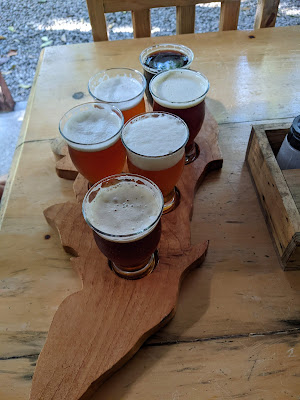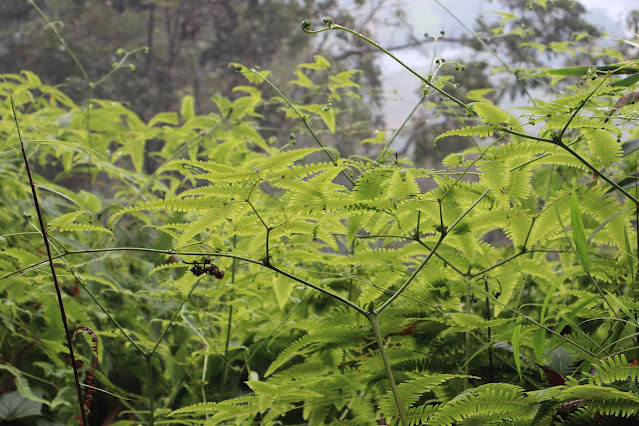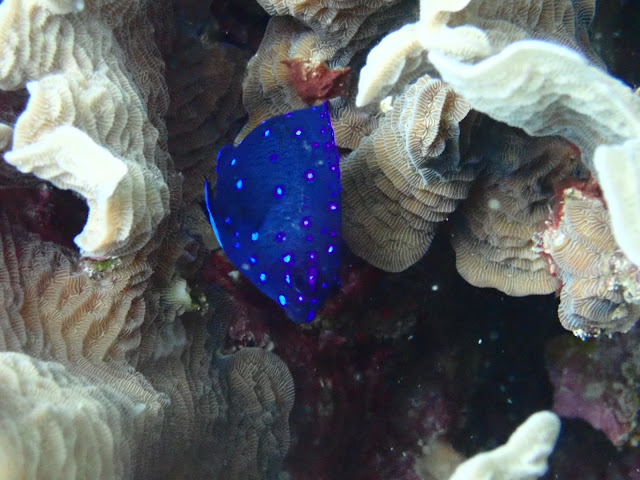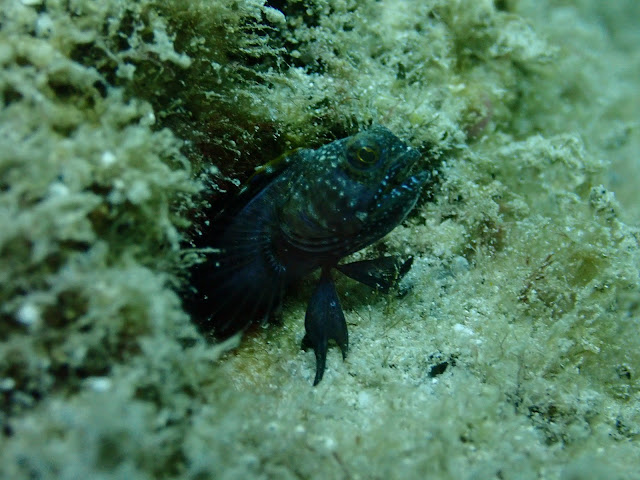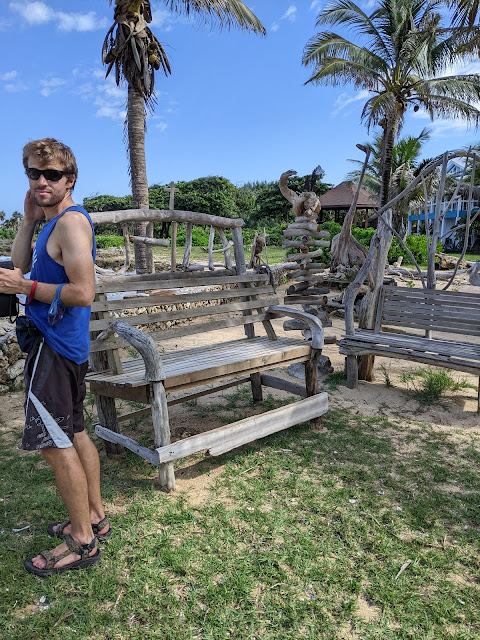We arrived in Santa Ana in the evening, and the bus which was headed to San Salvador had dropped us off at the side of the road by a gas station. With no internet available, a security guard at the gas station helped us call a taxi, though the guy droves us to the wrong hostel first as he didn't know ours. Thankfully that hostel owner (and Google maps) helped guide us to the right place - La Casa Vieja. The owner, Luis, was very kind and helpful, and immediately gave us information on activities in the area and how to get there, including the restaurant where we went for dinner.
The national dish of El Salvador is pupusas, which is like tortilla dough stuffed with some vegetable or other ingredient and cheese, and then fried, and its often served with tomato sauce and pickled vegetables. The restaurant we were directed to was a popular place called La Ceiba, which offered as many as 22 different fillings (!) and the choice of corn or rice dough. Some of our favorites were: garlic, cilantro, and carrot.
Our first full day in the country, we decided to take it easy as I was still recovering from my food poisoning as well as the gastritis that hit me after, so we took a chicken bus to Lago de Coatepeque, which is an old crater lake. It is easiest accessed by going to one of the lakefront hostels; our hostel in Santa Ana had a deal with the Captain Morgan hostel by the lake, which meant we got a free "day pass" and could spend a ocuple of hours sunbathing, swimming in the lake, and reading in a hammock with a pretty view. The only downside was the lack of food options; there was basically nothing except for the hostel unless we wanted to walk several kilometers in the mid-day heat.
 |
| Lake view |
 |
| Santa Ana |
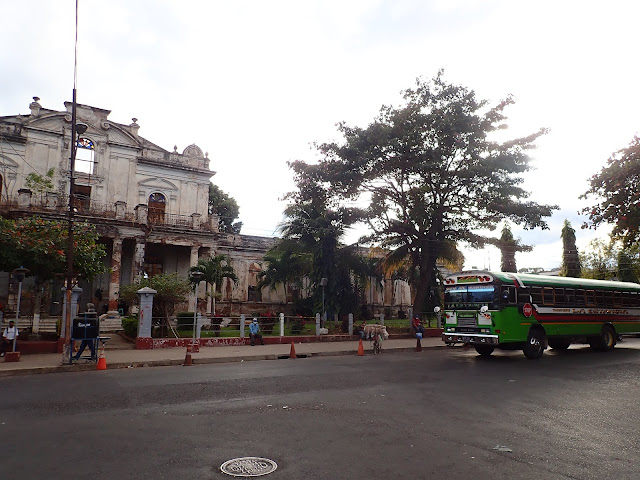 |
| Chicken bus |
The next day we were up extra early to catch the chicken bus heading to the
Santa Ana volcano, as there were only two buses per day going. After a long and slow ride, with the bus barely managing to climb the steep hill, we arrived at the parking lot with the other tourists. We were told that it was mandatory to go with a guide, so we all had to pay $3 per person, even though we barely saw the guide (who was at the very front) during the 1,5 hour walk to the summit. At the top we were rewarded with views of the surrounding landscape, as well as of the turqoise crater lake which smelled of sulfur.




Our next stop in El Salvador was the small town Ataco, situated along the Ruta de las Flores. This route is, as the name suggests, supposedly famous for its many beautiful flowers. However, even though it was "in the right season", we didn't really see that many flowers. We concluded that either there is a better time of the year to see them, or the rumors are a bit exaggerated. Ataco is one of the smaller villages along the route, but it has a lot of charm with its streetart and varieties of food options. There are also the typical souvenir stands along the main roads, selling basically the same souvenirs as we have seen all throughout Central America so far.
Ataco is also the place from where you can explore the El Imposible National Park with "El Salvatours", the one tour company situated in the town. We were a bit hesitant as we found it a bit expensive, but last minute there was another couple who booked the same tour, meaning we got a better price but also some nice company. The tour started with a pretty long drive, with the four of us and our guide standing on the back of the pickup truck. The road into the national park was not very well used, steep and full of holes and we occasionally had to duck to avoid branches hitting us in the head. As we started walking into the jungle, our guide occasionally stopped to tell us about different plants and their medicinal traits. We hiked along a river and its waterfalls, and in several places got to choose between jumping into the water or taking a detour around. In one spot, where the waterfall was high, we put on a harness and were rappelled down with a rope. Eventually, we stopped near a fall where we got homemade tortillas and guacamole for lunch, and where we could rest, swim a bit and enjoy the sun, before starting the steep hike back to the car. Shortly before we reached the end of the "trail", we heard something moving around in the leaves - an armadillo! We even saw another one hurrying across the road as we were driving back. All in all, we had a great time during this hike; it was the perfect amount of adventure, at a place where probably not that many tourists go, and with a great tour guide and good company.




The next day, we decided to explore the other towns along the flower route, traveling with the very cheap local chicken buses. Our first stop was Apaneco, another small village. Apart from some street art, there wasn't too much to see. We did pass some time (and spend some money) walking around in a big maze, which initially confused us as we expected an entry and an exit, rather than having the same entry/exit point and a center. As the maze was placed on a slope, we got plenty of exercise walking up and down the hill before we realized there was a center, and finding our way there.


Our next stop was Juayua, which is perhaps the most popular village to stay in along the route - although we found that we liked Ataco much more. It is most famous for the weekly weekend "food festival", which we were of course excited to see. However, we felt that it was a bit overrated, as it was just two streets serving mostly the same type of dish - meat or fish, with rice and salad. We did manage to find another food stall which served some yuca based dough, filled with cheese and fried - very tasty! We also met up with our friends from the hike and got ourselves some piña coladas made from fresh pineapple and served in the pineapple as well. Very good, but not very strong ^^

Although we felt a bit disappointed in the food festival, we immediately got in a better mood when we returned to Ataco and saw the food market in our own village, which lasted way into the night. Here we tried riguas (also made from yuca), something they called tortas served with cheese and "cream", elote (grilled corn on the cob), chile rellenoi (stuffed peppers) and ponche (a sweet milk-based drink spiced with rum and cinnamon). It was exactly was we wanted from a food market, with lots of local treats to taste.
 |
| Yuca with cheese and "cream" |
Our last day in El Salvador was spent in the capital, as we had to catch a very early bus the next day to Honduras. We didn't explore much; we stayed at a hotel near the bus terminal, and the area had mainly fast food and not much else to explore. In total we only spent a week in El Salvador, and could very well have spent another one there - doing the popular "7 waterfalls hike" from Juayua, or exploring the surf towns on the coast. However, we had to book our transportation and our acoomodation at the Dive Shop (!) in Honduras a few days in advance, so we had to guess at how many days we would want to stay. Still, we enjoyed our time in the country and felt that we got to explore several nice places and foods!
 |
| coffee! |





